Archive of news items - 2010
Ian Spooner interviewed about the Bloody Creek impact on CBC
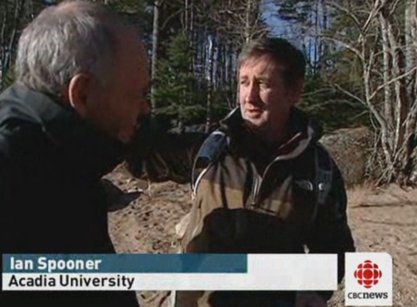
For several years Ian Spooner has coordinated a team of researchers including most of the faculty in the Geology program at Acadia University investigating the Bloody Creek impact structure south of Bridgetown, NS. On 15 January, CBC News provincially and nationally broadcast a short clip about the site, the potential it has for explaining the extinction of Ice Age megafauna, clips from a fly-over above the crater site, and showing Ian at work in the field and in the lab. You can watch the clip here.
Sandra Barr explains the "Chinese ruins" on Kellys Mountain
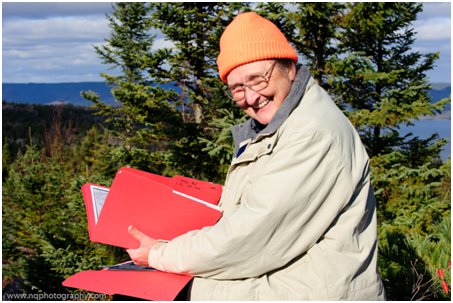 Over a year ago, Dr. Sandra Barr
participated in the filming of a documentary on the supposed Chinese ruins in
Kellys Mountain in Cape Breton Island described by author Paul Chiasson in his
book "The Island of Seven Cities". The
documentary entitled "Mysterious
Ruins: Cape Breton", produced by Ellis Entertainment Corporation, aired for
the first time on the History Channel on December 11th. Dr. Barr and archaeologist Dr. Stephen Davis
(Professor Emeritus, Saint Mary's University) were invited to participate to
provide expert opinion on the evidence (or lack thereof) for the existence of
the ruins, which Paul Chiasson claims were made by Chinese visitors prior to
the arrival of Columbus in the Americas.
During the filming of the documentary it was apparent to both Dr. Barr
and Dr. Davis that no evidence exists on Kellys Mountain for the supposed
"ruins", and both said so in the documentary, but their explanations are mostly
ignored in the film. In particular, the
rectangular supposed foundations for Chinese buildings are remnants of drilling
platforms during exploration of the area in the late 1980s for possible
development of a quarry on the mountain, and the supposed Chinese road was made
by a bulldozer. Such basic facts were
not included in the documentary, showing once again that one should not
necessary believe what one sees or hears in the media!
Over a year ago, Dr. Sandra Barr
participated in the filming of a documentary on the supposed Chinese ruins in
Kellys Mountain in Cape Breton Island described by author Paul Chiasson in his
book "The Island of Seven Cities". The
documentary entitled "Mysterious
Ruins: Cape Breton", produced by Ellis Entertainment Corporation, aired for
the first time on the History Channel on December 11th. Dr. Barr and archaeologist Dr. Stephen Davis
(Professor Emeritus, Saint Mary's University) were invited to participate to
provide expert opinion on the evidence (or lack thereof) for the existence of
the ruins, which Paul Chiasson claims were made by Chinese visitors prior to
the arrival of Columbus in the Americas.
During the filming of the documentary it was apparent to both Dr. Barr
and Dr. Davis that no evidence exists on Kellys Mountain for the supposed
"ruins", and both said so in the documentary, but their explanations are mostly
ignored in the film. In particular, the
rectangular supposed foundations for Chinese buildings are remnants of drilling
platforms during exploration of the area in the late 1980s for possible
development of a quarry on the mountain, and the supposed Chinese road was made
by a bulldozer. Such basic facts were
not included in the documentary, showing once again that one should not
necessary believe what one sees or hears in the media!
16 December 2010
Sara Akin to participate in ExxonMobil summer internship
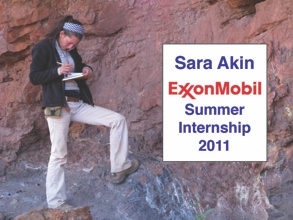 Congratulations to Sara Akin, graduate student in Geology, for securing a
coveted ExxonMobil summer internship!
Sara is looking forward to spending time at work in St. John's, Newfoundland,
where she will learn about the petroleum industry. Here she is shown working in the field on her
M.Sc. thesis in Western Australia, which is supervised by Dr. Peir Pufahl.
Congratulations to Sara Akin, graduate student in Geology, for securing a
coveted ExxonMobil summer internship!
Sara is looking forward to spending time at work in St. John's, Newfoundland,
where she will learn about the petroleum industry. Here she is shown working in the field on her
M.Sc. thesis in Western Australia, which is supervised by Dr. Peir Pufahl.
25 November 2010
Environmental Science programs gain accredited status
Acadia University is pleased to report that its Environmental Science program is one of the first three such programs in Canada to receive formal accreditation. An accreditation team from the Canadian Environmental Accreditation Commission visited Acadia in September, and evaluated the program, facilities, expertise of professors, opinions of employers and career paths of graduates to ensure qualifications are being met, in the same way that other professional programs like engineering or chemistry are evaluated.
The accreditation process assesses the overall quality of the program, facilities and personnel at Acadia, to ensure that the education our students receive is relevant to the needs of industry, government and other partners and that they have all the skills needed to be successful environmental scientists. It provides an independent confirmation that Acadia delivers a high quality environmental science program at both the major and honours level.
Acadia has offered an environmental
science program since 1995, being the first university in the Maritime
Provinces to do so, and has graduated over 160 students from its major and
honours programs since then. See also the Acadia news release with further information.
25 November 2010
Macleans takes a field trip

In preparation for its annual review of universities, Macleans
visited Acadia in October and did some photoshoots. Joining the second
year Geomorphology class, they learned about some of
the intricacies of beach and river processes. Here Dr. Spooner leads an
intrepid group across the marsh, with rearguard action by Prof. C.
Pufahl. Image published in Macleans, with caption, "Take a field trip:
in general, students at small schools, like these at Acadia University,
report higher levels of satisfaction than those in urban metropolises."
22 November 2010
AUGC 2010 - Acadia University
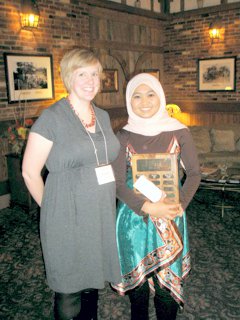 The Fletcher Geology Club and Department
of Earth and Environmental Science hosted the 60th Annual Atlantic
Universities Geological Conference (AUGC) on Nov. 28-30th. The conference was attended by approximately
85 students from Acadia, Dalhousie, Memorial, Saint Mary's, Saint Francis
Xavier, and UNB. In addition to social
events, the conference included three different field trips led by Acadia
professors on Friday and student presentations on Saturday, including 18 oral
presentations - the most ever at an AUGC - and seven posters. At the closing banquet on Saturday evening, Acadia
honours geology student Nor Afiqah Mohamad Radzi was awarded the Imperial Oil best
poster prize for her poster on her honours thesis research entitled
"Petrography of stratigraphic units in the subsurface in the Phetchabun Basin,
Thailand", supervised by Dr. Sandra Barr. For a more complete report on the conference
visit this page.
The Fletcher Geology Club and Department
of Earth and Environmental Science hosted the 60th Annual Atlantic
Universities Geological Conference (AUGC) on Nov. 28-30th. The conference was attended by approximately
85 students from Acadia, Dalhousie, Memorial, Saint Mary's, Saint Francis
Xavier, and UNB. In addition to social
events, the conference included three different field trips led by Acadia
professors on Friday and student presentations on Saturday, including 18 oral
presentations - the most ever at an AUGC - and seven posters. At the closing banquet on Saturday evening, Acadia
honours geology student Nor Afiqah Mohamad Radzi was awarded the Imperial Oil best
poster prize for her poster on her honours thesis research entitled
"Petrography of stratigraphic units in the subsurface in the Phetchabun Basin,
Thailand", supervised by Dr. Sandra Barr. For a more complete report on the conference
visit this page.
Nor Afiqah Mohamad Radzi receiving the Imperial Oil poster award from Sarah Trend of Imperial Oil Resources, St. John's, NL.
3 November 2010
A visit to the Precambrian-Cambrian boundary
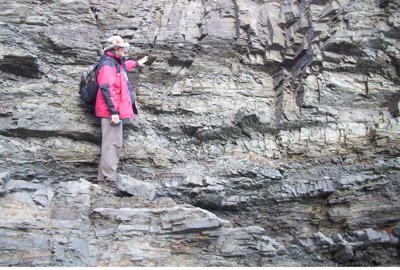 Sandra
Barr recently had an opportunity to visit the
internationally recognized "global stratotype" (type section) for the
Precambrian-Cambrian boundary at Fortune Head, Newfoundland. In
the photograph her left hand is on the boundary (age 542 million years).
This site was selected because sediment deposition was continuous across
the boundary at this location. Evidence of abundant life on the sea
floor in
the form of trace fossils begins about 2 metres (a few million years)
above
this boundary in the Early Cambrian. The
field trip was organized by the Newfoundland Section of the Geological
Association of Canada.
Sandra
Barr recently had an opportunity to visit the
internationally recognized "global stratotype" (type section) for the
Precambrian-Cambrian boundary at Fortune Head, Newfoundland. In
the photograph her left hand is on the boundary (age 542 million years).
This site was selected because sediment deposition was continuous across
the boundary at this location. Evidence of abundant life on the sea
floor in
the form of trace fossils begins about 2 metres (a few million years)
above
this boundary in the Early Cambrian. The
field trip was organized by the Newfoundland Section of the Geological
Association of Canada.
[Click on image for larger version.]
12 October 2010
2009 Grads at Work in Arizona
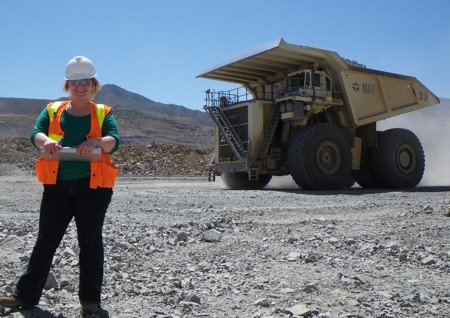
Stephanie Anderson and Kieran McDonald now live in Tucson, Arizona.
Stephanie is enjoying working in the copper mine, where she is
employed with ASARCO. She has also had a couple of other job
offers, which she says is nice! Kieran has started a M.Sc. under the
direction of Marc Brusseau at the University of Arizona. His project
focuses on the hydrogeology/ environmental science on mining pollution
on the aquifers under Tuscon.
30 September 2010
Geology field studies in Cape Breton Island
Fifteen students accompanied Sandra Barr and Rob Raeside on a
geological tour of Cape Breton Island on the second weekend of term. In
spite of a drive through heavy rain to get there, they enjoyed perfect
weather for the investigation of terrane relationships in the
Appalachians, including a drive down a subduction zone as they climbed
into the Highlands, a two-minute traverse of the Canadian Shield (Blair
River Inlier), and spectacular columnar jointing in rhyolite,
cross-bedding in sandstone, and waves at Louisbourg. They were joined by
Mike Young (and Ginger)
from Dalhousie, and all still seemed to be smiling (and learning!) even
at stop 25! Here five graduate students (Jean-Luc, Sara, Hilary,
Robert and Ronald experiment with some cross-cutting relationships atop
Cape Smoky (Cambrian granite).
Photos by Nor Afiqah Mohamad Radzi
23 September 2010
EnvSci major studying in New Zealand
Dewey Dunnington (on left, below) has opted to take his penultimate term at the University of Auckland. He writes:
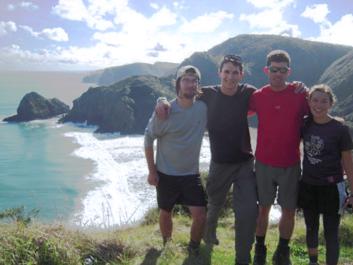 Greetings from New Zealand! As a fourth year
environmental science major at Acadia, I spent quite a bit of time looking at
pictures of New Zealand in powerpoints, and decided to give the place a look
over myself by spending a semester there during my fourth year. At the
University of Auckland, I was not disappointed. So far classes have entailed a
week-long field trip conducting a hydrological study, and day trips to a
restored wetland and a restored island bird reserve, not to mention travels
outside of class to the volcanoes near Lake Taupo and the volcanic terrain of
the north island. The next round of adventures includes the mountains, glaciers
and fjords of the south island, and even though it took me a trip halfway
around the world to fully realize it, I'm glad I have three years of Acadia
Environmental Science to draw from looking out onto the landscape. Kia Ora!
Greetings from New Zealand! As a fourth year
environmental science major at Acadia, I spent quite a bit of time looking at
pictures of New Zealand in powerpoints, and decided to give the place a look
over myself by spending a semester there during my fourth year. At the
University of Auckland, I was not disappointed. So far classes have entailed a
week-long field trip conducting a hydrological study, and day trips to a
restored wetland and a restored island bird reserve, not to mention travels
outside of class to the volcanoes near Lake Taupo and the volcanic terrain of
the north island. The next round of adventures includes the mountains, glaciers
and fjords of the south island, and even though it took me a trip halfway
around the world to fully realize it, I'm glad I have three years of Acadia
Environmental Science to draw from looking out onto the landscape. Kia Ora!
16 September 2010
E&ES majors star in Acadia's opening football game
As reported in The Chronicle Herald, Kyle Graves (Geology) threw two touch-down passes to Stu Clow (Environmental Science) for the only two majors in the game.
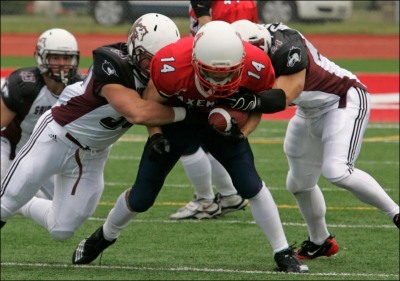
Photo Caption:Greg Daly, left, and Jeff Hecht of St. Mary’s tackle
Acadia’s Stu Clow during AUS football action in Wolfville on Saturday.
Clow scored two touchdowns in Acadia’s 17-7 win.
Stu Clow was subsequently declared "athlete of the week".
12 September 2010
Acadia professor participates in 40th "Eurogranite" event
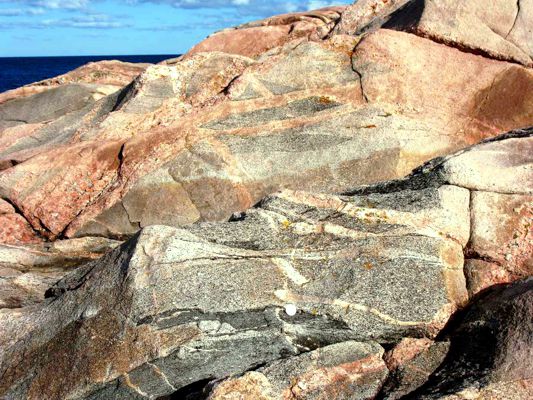 Sandra
Barr led a group of about 20 geologists from 9 different countries on a
3-day geological
tour of Cape Breton Island, Sept. 2-4. It was the 40th anniversary
of "Eurogranites", an annual get-together of international experts on
the origin and evolution of granitic rocks, and the first time that the
event had been held outside Europe. The participants were interested to
see the
varied (more than 60 bodies with different ages and/or chemical
characteristics) granites exposed on the island. Luckily the rain
and wind associated with Hurricane Earl held off until the very last
field stop, and provided a rather dramatic ending to the field trip.
Sandra
Barr led a group of about 20 geologists from 9 different countries on a
3-day geological
tour of Cape Breton Island, Sept. 2-4. It was the 40th anniversary
of "Eurogranites", an annual get-together of international experts on
the origin and evolution of granitic rocks, and the first time that the
event had been held outside Europe. The participants were interested to
see the
varied (more than 60 bodies with different ages and/or chemical
characteristics) granites exposed on the island. Luckily the rain
and wind associated with Hurricane Earl held off until the very last
field stop, and provided a rather dramatic ending to the field trip.
6 September 2010
Acadia hosts project students from Cambridge

Over
the summer the E&ES department was pleased to provide local
support for five venturous summer students from Cambridge University in
England. As part of their degree program, they are required to find
somewhere in the world to map for 28 days, and this group of Christine,
Ekbal, Charlie, Aaron and Becky chose the intriguing complexities of the
White Rock-Lumsdens Dam area, where slates a-plenty are interbedded
with quartzite marker horizons, folded into a plunging anticline,
intruded and contact metamorphosed by the South Mountain Granite and
overlain by the Triassic sandstones. In two groups, these students set
out to conquer the wilderness (so many trees!), battle the aggressive
wildlife (horseflies were their worst enemy) and intrigue the local
population as they appeared out of ditches, looking for that one
critical outcrop. We enjoyed having them around for the summer!
18 August 2010
Leah Chiste goes to Chile for samples
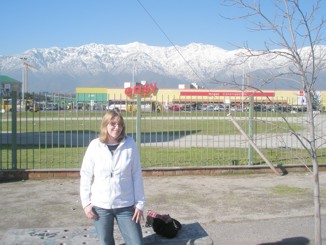
Geology honours candidate Leah Chiste and her supervisor, Cliff
Stanley, travelled to Chile collect material for Leah's thesis project
on the techniques of partial digestion in geochemical analysis.
While in Chile, they sampled six different
sites at the Toki Cluster of copper deposits near Calama, in the north
of the country. They sampled every 10 cm down trenches about 2 m deep
and
got absolutely dust-coated in the windy Atacama Desert. Sponsored by
CODELCO, they found the company welcoming and eager to help with the
project. Leah writes, "It seemed like a wonderful place
to work and I hope I get the opportunity to work with them again. I got
to
explore some of Santiago after the sampling was completed. Some of the
things I
saw in Santiago were the Concha y Toro Vineyard, the Los Dominicos
Market and
the Universidad de Chile. It was a beautiful city and I wish I could
have had
more time than just two days there."
Here
Leah is standing outside the Las Torres underground station, with a
fantastic view of the snow covered Andes in the background.
5 August 2010
Acadia Professor carries the flag at Moncton IAAF Games
Professor
Sandra Barr was honored to serve as one of six flag bearers for the Opening
Ceremony of the IAAF World Junior Track and Field Championships in Moncton, New
Brunswick on July 19th. The flag bearers were chosen for the lasting
impression they have made in the world of sports in New Brunswick, Canada, and
the world. They had the privilege of marching in the IAAF flag, following the
parade of athletes, in front of a live audience of thousands of spectators and
millions of television viewers around the world.
More details on the Moncton 2010 website, including biographies of the flag bearers.
20 July 2010
Thesis Defence - David Swanton
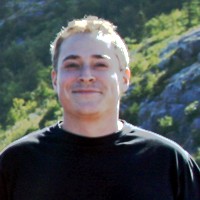 David
Swanton successfully defended his thesis on 16 July before examiners
John Waldron, Chris White, Rob Raeside, and Sandra Barr. Entitled "Field
relationships, petrology, tectonic setting and economic potential
of metamorphic and igneous rocks in the Whycocomagh Mountain-Aberdeen
Ridge area, Cape Breton Island, Nova Scotia", he used the results of his
mapping to demonstrate that the entire area lies within the Bras d'Or
terrane, that rocks previously mapped as gneiss are in fact Late
Neoproterozoic contact metamorphic rocks, and that the quartzite on the
Aberdeen ridge is extensively mylonitized - although not apparently as
part of any terrane-bounding shear zone system.
David
Swanton successfully defended his thesis on 16 July before examiners
John Waldron, Chris White, Rob Raeside, and Sandra Barr. Entitled "Field
relationships, petrology, tectonic setting and economic potential
of metamorphic and igneous rocks in the Whycocomagh Mountain-Aberdeen
Ridge area, Cape Breton Island, Nova Scotia", he used the results of his
mapping to demonstrate that the entire area lies within the Bras d'Or
terrane, that rocks previously mapped as gneiss are in fact Late
Neoproterozoic contact metamorphic rocks, and that the quartzite on the
Aberdeen ridge is extensively mylonitized - although not apparently as
part of any terrane-bounding shear zone system.
David is
working this summer on the Yukon-Alaska border, and will return there
after making any corrections to his thesis.
19 July 2010
Jennie Pick learns environmental stewardship on 4H exchange in England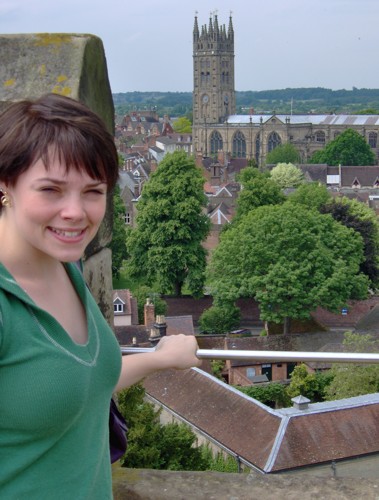
Jennie
was sponsored by the W.
Garfield Weston Foundation as one of three Canadian delegates
who spent a week in each of three different England counties. Living
each week with a different host family
involved in agriculture allowed her also
to enjoy different cultural experiences across the country, but found
all were very concerned with environmental stewardship. The exchange
will benefit her honours thesis at Acadia where she will use the
approaches in England as a
model for incorporating ecosystem services into agricultural land
management. She also looks forward to hosting a delegate from the United
Kingdom in October and introducing her to Nova Scotia and Acadia
University.
Jennie atop Warwick Castle with the cathedral in the background.
14 July 2010
What attracts applicants to university Environmental Science programs?
See Academica Group's UCAS White Paper, "Attracting Students to Environmental
Science," a survey of 150,000 Canadian students applying to
University this year. "EnviroSci applicants are pragmatic careerists,
attracted by co-op and undergraduate research
opportunities, as well as ease of admission. But they also appreciate
their own environment – campus food services, residences, and off-campus
urban life."
The same study also shows that applicants to Science programs in general are attracted by high-profile
research and the opportunity to participate in research, the latest technology, and merit-based scholarships. See White Paper 5 for more details.
8, 13 July 2010
Peir Pufahl publishes in Geology on Precambrian oceanography
Dr.
Peir Pufahl and collaborators from the University of Wisconsin and Queen's
published in the latest issue of Geology (vol. 38, pages 659-662) on the
Paleoproterozoic sulfidic ocean transition. This oceanographic event
occurred ~1.8 billion years ago and is likely responsible for nearly a one
billion year hiatus in the evolution of eukaryotes. The Animikie Basin of
the Lake Superior region (see map) in North America has become the benchmark for
understanding this transition. Pufahl and colleagues show that the
Animikie Basin does not contain an accurate record of this oceanographic
change, calling into question the timing of this important event in early Earth
history.
25 June 2010
Gulf oil leak clean-up involves Acadia ENVS grads Acadia Environmental Science graduates Scott
Ryan ('05, '08) and Claire McIntyre ('09) have been working on the
response
effort for the Deepwater Horizon oil spill in the Gulf of Mexico. Claire
and
Scott are representing the Department of Fisheries and Oceans Canada and
are providing
assistance to British Petroleum in the relief effort. Their work
includes
providing small particle analysis and fluorescence analysis data that are
critical in determining the effectiveness of the use of chemical
dispersants in
oil spills. The research is conducted aboard the research vessel RV
Brooks
McCall. The data collected by the science team is utilized by the U.S.
EPA and
BP and is accessible to the public via the web.
Acadia Environmental Science graduates Scott
Ryan ('05, '08) and Claire McIntyre ('09) have been working on the
response
effort for the Deepwater Horizon oil spill in the Gulf of Mexico. Claire
and
Scott are representing the Department of Fisheries and Oceans Canada and
are providing
assistance to British Petroleum in the relief effort. Their work
includes
providing small particle analysis and fluorescence analysis data that are
critical in determining the effectiveness of the use of chemical
dispersants in
oil spills. The research is conducted aboard the research vessel RV
Brooks
McCall. The data collected by the science team is utilized by the U.S.
EPA and
BP and is accessible to the public via the web.
22 June 2010
Goldschmidt Conference, Knoxville, Tennessee
Cliff Stanley attended the Goldschmidt 2010
conference, named after the 'father of geochemistry' Victor Goldschmidt, in
Knoxville, Tennessee in June. There, he presented a lecture entitled
"Documenting the Physicochemical and Thermodynamic Changes Associated with
all Possible Geochemical Reactions in Rocks Using Gale Vector Space" in a
session entitled "Simulation of Metamorphic Processes - Theory,
Experiments, and Numerical Models". In July, Cliff will be heading to
Chile with honours student Leah Chiste to collect samples for her honours
thesis in the Toki porphyry copper district outside Calama, Chile. This project
is supported by a number of sources, including CODELCO, Chile's national copper
mining company.
21 June 2010
CUESN meetings in Toronto
The Canadian Universities
Environmental Science Network met at George Brown College in Toronto in
early June. Linda Lusby was chair of CUESN until December, and Rob
Raeside attended on behalf of the department. A major item of discussion
was in impending accreditation of programs (Acadia hopes to participate
this fall). While there, Rob enjoyed presentations by several
environmental practitioners, and was especially impressed by the work
and talk by David Miller, Mayor of Toronto, who has spearheaded major
new practices in the city (green roofs, cladding on high rises, expanded
subway, Lake Ontario deep water cooling, new streetcars, etc.) See Living Green in
Toronto.
15 June 2010
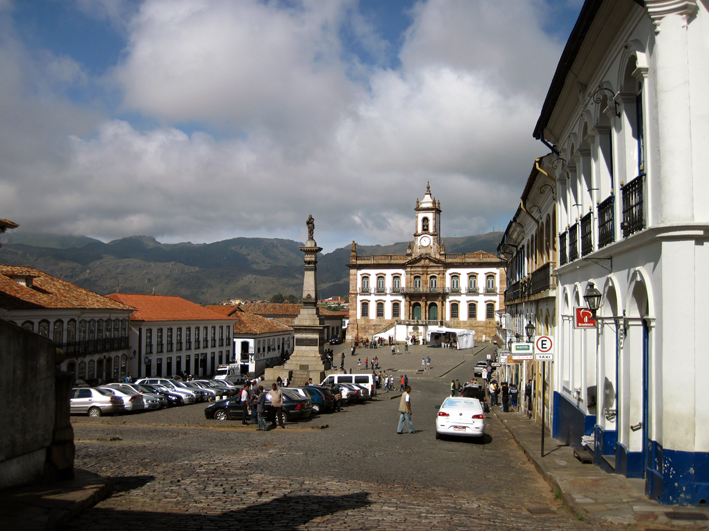 Peir Pufahl presents in Brazil
Peir Pufahl presents in Brazil
Dr. Peir Pufahl
recently travelled to Ouro Preto Brazil to attend Simexmin 2010,
Brazil's national conference on mining and mineral exploration. Dr.
Pufahl is a leading chemical sedimentologist and was invited by the
Society of Economic Geologists to present a talk and short-course on
phosphorite exploration. Phosphorite is the primary source of phosphorus
for fertilizer manufacture. The discovery of new phosphate deposits is
critical since current reserves are projected to last only another 30 to
40 years.
7 June 2010
Graduate Award Winner
Robin Westland,
graduate from the BSc (Geology)program this spring, has received the
Alexander Graham Bell Canada Graduate Scholarship award of $17,500 to
pursue graduate studies. She will be starting at Queen's University in
the fall, studying mineralogy with Dr. Ron Peterson. Congratulations,
Robin!
28 May 2010
Gabe Nelson's thesis published in Sedimentary
Geology
Former graduate student of Peir Pufahl, Gabe Nelson,
had the results of his MSc research at Acadia published in Sedimentary
Geology. The work provides new information on the biogeochemical cycling
of phosphorus in the early Earth. Gabe is currently employed as a
research scientist with Geoscience Australia. The full citation for his
paper is: Nelson, G.J., Pufahl, P.K., and Hiatt, E.E., 2010.
Paleoceanographic constraints on Precambrian phosphorite accumulation,
Baraga Group, USA. Sedimentary Geology, v. 226, p. 9-21.
20 May 2010
CARE lab receives funding
Nelson
O'Driscoll's CARE (Centre for Analytical Research on the Environment)
lab received 2009-2010 funding from the Acadia Ducks Unlimited Canada
Partnership grant, and Environment Canada and Natural Resources Canada
as part of the CARA mercury science program. The $57,000 award will be
used to investigate the paths by which mercury is taken up in marshes
and wildlife. Nelson also received NSERC CREATE funding in collaboration
with researchers at St. FX and Memorial universities to engage graduate
students entering the workforce to meet the challenges imposed by a
changing climate.
20 May 2010
Bloody Creek meteor impact crater, near
Bridgetown, NS
Ian Spooner, Trevor Brisco (Acadia Honours B.Sc.)
and co-supervisors Peir Pufahl (Acadia) and Jared Morrow (University of
California, Santa Barbara) established that a multiple meteor impact
event occurred in Southwest Nova Scotia. The Bloody Creek impact crater
near Bridgetown Nova Scotia was the subject of a recent publication in
the journal Meteoritics and Planetary Sciences and is confirmed
as one of only three low angle impact structures on Earth.
20 May
2010
Acadia at GeoCanada 2010
Several members of
the E&ES department attended the GeoCanada 2010 conference in
Calgary in May. Sandra Barr presented a paper on acritarchs in Cape
Breton Island, Cole Edwards presented findings from his MSc thesis on
the fossil microbial communities in the Labrador Trough, and Trevor
Brisco discussed the Bloody Creek impact structure.
18 May 2010
CSEG Challenge Bowl - Leah and Alex runners up!
Leah
Chiste and Alex Kaul participated in the 2010 CSEG Challenge Bowl at
GeoCanada 2010, succeeding right to the final where they took the second
place, losing out to a team composed of a PhD student in Geophysics and
an MSc student in Sedimentology from the University of Western Ontario.
Well done - especially since only one of you has actually taken a
Geophysics course!
18 May 2010
2010 Graduates celebrate
A total of 27
graduates who have graced the halls of Huggins this past few (or
several) years were eligible to cross the stage of Convocation Hall in
May:
MSc (Geology): Cole Edwards, Edwin Escarraga and Tamara Moss
MSc
(Applied Geomatics): Kathryn Leblanc
BSc (Honours, Environmental
Science): Jillian Hanmore, Emma Hebb, Kelly Moores and Miranda Saroli
BSc
(Honours Geology): Annas Abdul Aziz, Trevor Brisco, Vince Doucette,
Alex Kaul, Harun Alrashid, Chris Stevens
BSc (Environmental Science):
Scott Cassidy, Jeff Sutherland, Ben Sweet
BSc (Geology): Kate
Albright, Chancy Cheng, Mark Dufault, Cassie Gaudet, Jeremy Kozlowski,
Dan Lake, Kyle Pedersen, Joalan Pinto, Ned Welty, Robin Westland.
Congratulations
to all, and especially to Jillian Hanmore and Trevor Brisco, the
recipients of the University Medals in Environmental Science and
Geology, respectively.
17 May 2010
Congratulations to Jennie Pick, recipient of the
Beveridge Scholarship
Jennie is the recipient of the Beveridge
scholarship for the year 2010-11 academic year. This prestigious award
is made to one student entering the senior year of his/her program in
the Faculty of Pure and Applied Science and intending to proceed to
graduate studies.
14 May 2010
Jean-Luc Pilote wins research grant from the Geol. Soc. America
MSc candidate in Geology Jean-Luc Pilote has been awarded a prestigious grant from the Geological Society of America in support of his MSc thesis project.
The primary role of the GSA research grants program is to provide partial support of Master's and Doctoral thesis research in the geological sciences for graduate students at universities in the United States, Canada, Mexico and Central America. Jean-Luc's successful application to GSA is entitled "Petrology, petrogenesis, tectonic implications and economic potential of the Landry Brook and Dickie Brook plutons, northern New Brunswick, Canada". His work is supervised by Professor Sandra Barr of the Department of Earth and Environmental Science, Acadia University.
15 April 2010
Year-end banquet
On Saturday, 27 March, students from the Fletcher Club and the ESSO gathered in the Clark Commons to celebrate the end of the year. Following a delicious turkey dinner, we were treated to a retrospect review of the year with scores of pictures of budding environmental scientists and geologists in actions, in all sorts of ways. The year-before-our-eyes review was accompanied by live music from Leah, Alex, Chancy and Janine.
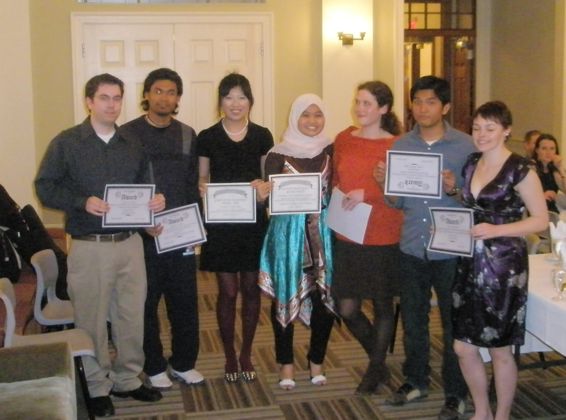
Students recognised as winners of awards and scholarships
included (left to right) Matt Pitts, Harun Alrashid, Chancy Cheng, Nor
Afiqah Mohamad Radzi, Robin Westland, Annas Abdul Aziz, Jennie Pick.
The FGC presented the department with a beautiful sample of azurite and
chrysocola, engraved with the class year - you can see it on display in
the
cabinet outside the main classroom in Huggins third floor.
31 March
2010
APICS, St. John's NL
Environmental Science Honours students Jillian Hanmore, Emma Hebb,
Kelly
Moores and Miranda Saroli attended the APICS conference March 5-6 in
St.
John's, accompanied by Dr. Nelson O'Driscoll.
All four students were in the running for the oral presentation award.
Good
work!!
16 March 2010
Luke Marshall attends the Petroleum Geoscience Field Methods courses in Trinidad
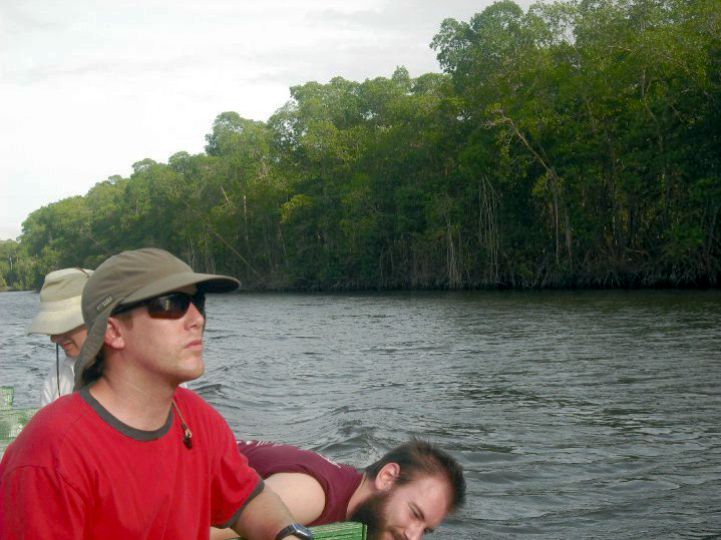
Luke depth-sounding the channel morphology in the Caroni Delta waters
The Petroleum Geoscience Field Methods course led by Dr. Grant Wach of Dalhousie University embarked on an annual field trip to Trinidad during Study Break 2010 to study the petroleum systems of the Trinidad basins fed by the Caroni Delta. The trip was mainly sponsored by Nova Scotia Department of Energy and Shell, with supporting funding from Petrotrin, BP T&T, Imperial Oil, Ten Degrees North, and comprised ten students from Dalhousie University, and one student from each of Acadia, St. Mary’s, and St. Francis Xavier Universities. Trinidad has been active in oil and gas exploration and production for nearly a century. Areas of study included: oil seeps, exposed oil reservoirs, the Pitch Lake, mud volcanoes, offshore drill cores, and deltaic depositional outcrops containing linked delta top, delta front and prodelta facies successions. These outcrops are analogous to the basins offshore Nova Scotia and provide an invaluable resource for students to conduct basin/reservoir research. See more details and photos on this page.
9
March 2010
Atlantic Geoscience Society Colloquium, Wolfville
About 16 Geology, Applied Geomatics,
Environmental Science and Biology students and 5 Geology faculty
participated in this conference (many of them were involved in running
it!)
Nearly 200 delegates attended from all across the Atlantic provinces,
Ontario, Saskatchewan, Colorado, Wales and China. Winners of the Graham
Williams award for best poster were: Harun
Alrashid (first place), Chancy Chang and Alexander Kaul (honourable
mentions) - all Acadia students. Rob
Raeside was also awarded the Distinguished Service Award of the
Society.
8 February 2010
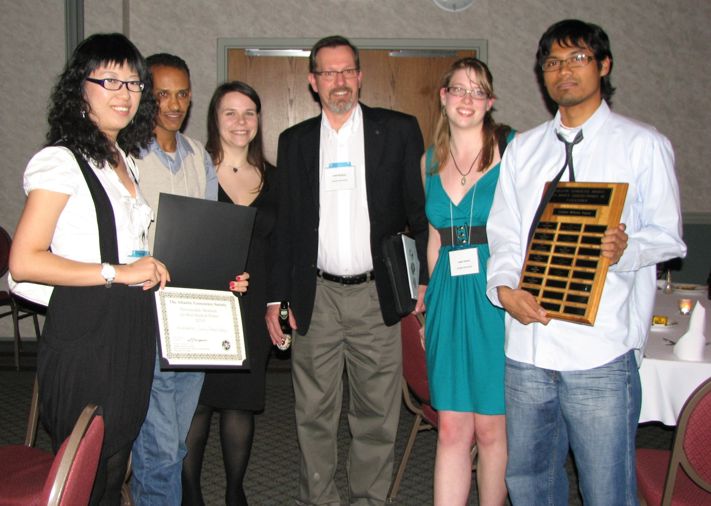
Some of the Acadia participants at the Colloquium (left to right Chancy Cheng, honorable mention poster; Biniam Tesfay; Kara-Lynn Scallion, grad of 2008; Dr. Cliff Stanley; Leah Chiste; Harun Alrashid, winner poster award).
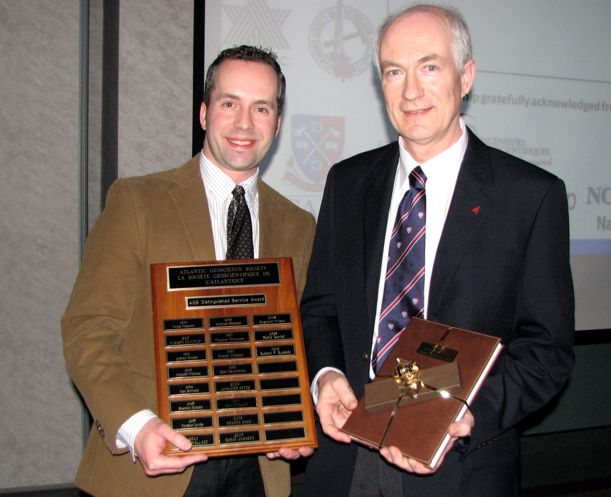
Rob Raeside receiving the Laing Ferguson Distinguished Service Award from Mike Parsons.
SETAC Conference, New Orleans
Congratulations to Sam
Edmonds (MSc BIOL) and Jillian Hanmore (BScH ENVS)
who both won student presentation awards from the Society of
Environmental Toxicology and Chemistry (SETAC) North America
conference this past November in New Orleans.
January 2010
For previously listed events go to the in 2009 archive.
